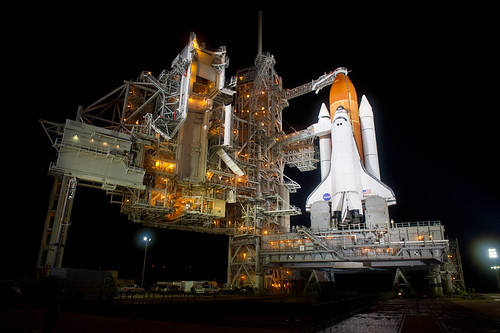Tag: Endeavour
STS-134 Rotating Service Structure Retract Time Lapse
STS-134 Space Shuttle Endeavour Post-scrub Briefing
Today’s STS-134 Space Shuttle Endeavour launch was scrubbed due to a malfunction of the heating elements on an Auxiliary Power Unit (APU) which controls the hydraulics which controls movement of the main engines (SSME), aero surfaces, basically everything on the orbiter. This was a main system, which had some redundancy, but an ascent and decent it is a critical part of steering the orbiter. So it makes sense that the launch was scrubbed. You can watch a snippet of the press conference above, or watch the whole Post-scrub Briefing (warning, long).
They won’t know until tomorrow how serious the issue is – it will take a bit more time to safe the Shuttle: mainly the ET hydrogen takes 24 hours to fully remove, burn-off then purge the tank with helium to make it safe to work on the Shuttle.
Right now STS-134 is set to launch no earlier than Monday at 2:33 pm, which will undoubtably be adjusted when they can get into the rear avionics bay to repair the heating system. According to Space Flight Now:
NASA managers do not yet know what it will take to resolve the problem, but they are hopeful a faulty thermostat in a heater circuit is to blame. If so, the shuttle could be ready for another launch attempt as early as Monday at 2:33:56 p.m.
But if the problem requires a cockpit fuse panel swap out, or installation of a replacement electrical box in the shuttle’s aft engine compartment, Endeavour’s launch on its 25th and final mission could be delayed until May 9 or 10, after the planned May 6 launch of an Atlas rocket carrying a missile early warning satellite.
Personally this is a disappointment as I had contingencies for both a 24 and 48 hour scrub, but a Monday launch basically is out of the question due to money, but also time: I would be back at work no earlier than Tuesday. And frankly the thought of waking up again at 5am to wait in a series of lines again wasn’t to appealing. Additionally, Monday isn’t a lock and I have other commitments. So I will be watching the ascent on NASA TV (which is pretty awesome, by the way).
Space Shuttle Endeavour STS-134
Storm over STS-134 launch pad
T-11 hours Hold
Right now NASA is in the middle of the T-11 hours hold (more info on shuttle countdowns), a built-in hold of 13 hours 22 minutes, with the following main tasks to be accomplished:
- Weather and engineering briefings
- Pad debris inspection and closeout
- Flight crew equipment late stow
- Move rotating service structure to “park” position
- Activate the orbiter’s inertial measurement units and communications systems
- Perform ascent switch list
Sometime today, the official launch time was shifted one second, but the planned launch is still 3:47 p.m. EDT Friday which is in the middle of the ten minute launch window. During the planned T-9 minute hold, the shuttle managers will make adjustments to the launch time as required.
If you want the current mission minutiae, watch STS-134 – Countdown Status Briefing April 28.
The countdown will resume at T-11 hours (11:22 p.m. EST).
The weather forecast calls for a 70 percent chance of favorable conditions at launch time – so pray for mojo.
As a personal matter, I’m in Orlando now, in the suburban oasis which is the airport Holiday Inn.
STS-134 Crew Arrival
On the Space Shuttle External Tank

The very large, very orange, object on the Space Shuttle stack is the External Tank (ET) which holds fuel in the form of iquid hydrogen (LH2) fuel and liquid oxygen (LO2) oxidizer which mix in the three Space Shuttle Main Engines (SSME). The ET is the only non-reusable lift object: the ET is jettisoned just over 10 seconds after Main Engine Cut Off (MECO).

Above: the External Tank. The right hand pipe is the LO2 feedline which enters the shuttle near the orbiter LH2 feedline and umbilicals at the aft attachment point.
The ET is covered in foam in order to keep the fuel liquid – this is the same foam which cause the catastrophic loss of the Space Shuttle Columbia when during liftoff a suitcase-size piece of thermal insulation foam broke off from the ET, striking Columbia’s left wing panels. The specific piece of foam which broke off (the Left Bipod Foam Ramp) was designed to reduce aerodynamic stresses around the bipod attachment to the shuttle, and on further missions this piece was removed from design and flight.

There are three main parts to the ET: the iquid hydrogen (LH2) fuel tank (bottom), liquid oxygen (LO2) oxidizer tank (top) and the intertank connecting the two pieces. The large exterior line is the LO2 feedline which is 17″ in diameter which is connected to the space shuttle at the bottom mating points.
The specific ET which is being flown on STS-134 is ET-122 which was refurbished after damage during Hurricane Katrina, being fully certified and flight-worthy. As a NASA manager stated, It might not be pretty, but it is fully flight ready.
To mark the return of ET-122 to flight-worthy status, Lockheed Martin created a Return to Flight logo which was applied to the Intertank Access Door at the request of NASA, the first of its kind. The logo is below (courtesy of Lockheed Martin):

Below are photos of the ET, LO2 Feedline, and space shuttle mating section:
ET-122 Rollout to Barge (NASA, 9/20/10) by NASA’s Marshall Space Flight Center:
External tank-shuttle bipod:
17″ O2 Feedline at Top of the External Tank:
LH2 Feedline (O2 Feedline behind) at orbiter aft attachment point:
- Space Shuttle External Tank
- Orbiter propulsion datasheet from NASA
- Solid Rocket Boosters
- Shuttle main engines
- mobile launcher platform
This is another in a series of posts documenting my time around the liftoff of STS-134 Space Shuttle Endeavour. For more posts, check out my STS-134 Launch Page.

How Does the Space Shuttle Stay on the Pad? Eight. Big. Bolts.
Short answer: eight giant bolts.

Long answer: the Space Shuttle is attached to the External Tank (ET) which is attached to the two white Solid Rocket Boosters (SRB) which is bolted to the mobile launcher platform (MLP) with eight 28″ long (3.5″ diameter) bolts, four on each SRB. At T-6.6 seconds the Shuttle main engines (SSME) ignite, and then at T-0, the SRBs ignite; the bolts are detonated releasing the combined Shuttle stack.
If you look at the below photo of the space shuttle Enterprise sitting on the MLP, you can see how the orbiter hangs from the external tank which is attached to the solid rocket boosters:
Below are photos of the SRBs and the hold-down posts (all photos by Steve Patlan):
Also note that when the main engines ignite, the direction of thrust is off vertical axis, which causes the shuttle stack to do what is called the “Shuttle Twang,” tilting forward and then settling back vertical (this is why the main engines fire at T-8 seconds). Here’s a video of the external tank in real-time:
Update: Here’s a photo from the bottom of the flame trench of the business-end of the SRB. Note the two Sound Suppression Water System (SSWS) nozzles on the left side.
More Information:
This is another in a series of posts documenting my time around the liftoff of STS-134 Space Shuttle Endeavour. For more posts, check out my STS-134 Launch Page.














